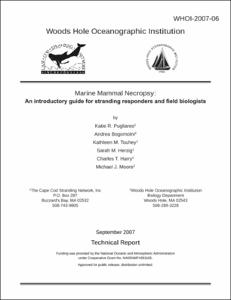Marine Mammal Necropsy: an introductory guide for stranding responders and field biologists.

View/
Average rating
votes
Date
2007Author
Pugliares, Katie R.
Bogomolni, Andrea
Touhey, Kathleen M.
Herzig, Sarah M.
Harry, Charles T.
Editor
Moore, Michael J.
Status
PublishedPages
133pp.Metadata
Show full item recordAbstract
Necropsies are performed to get further insight into the cause of death: in the case of marine
mammals this may establish the cause for stranding or other mortalities. The necropsy generates
a series of gross observations that establishes a differential diagnosis. Subsequent investigations,
such as histopathology, are then guided as the various potential diagnoses are eliminated until an
etiology is established. Regardless of whether it is a common chronic disease, fisheries interaction,
or an emerging zoonoses, by consistently conducting necropsies, trends in population health
can be monitored.
This guide is designed to establish a base level of proficiency in marine mammal necropsy techniques.
It is written for stranding network members who do not have a formal pathobiological
training and have limited knowledge of anatomy. Anatomical and pathological jargon has been
kept to a minimum.
This manual is divided into six sections: preliminary data, sample management, pinniped,.....
Resource URL
https://darchive.mblwhoilibrary.org/handle/1912/1823Publisher
Woods HOle Oceanographic InstitutionWoods Hole, MA
Series;Nr
Woods Hole Oceanographic Institution Technical Report; 2007-06Document Language
enSustainable Development Goals (SDG)
14.aEssential Ocean Variables (EOV)
N/ADOI Original
10.1575/1912/1823Citation
Pugliares, K. R., Bogomolni, A., Touhey, K. M., Herzig, S. M., Harry, C. T., & Moore, M. J. (2007) Marine mammal necropsy: an introductory guide for stranding responders and field biologists.Woods Hole, MA., Woods Hole Oceanographic Institution, 133pp. (WHOI Technical Report 2007-06). DOI: https://doi.org/10.1575/1912/1823Collections
The following license files are associated with this item:
 Repository of community practices in Ocean Research, Applications and Data/Information Management
Repository of community practices in Ocean Research, Applications and Data/Information Management
